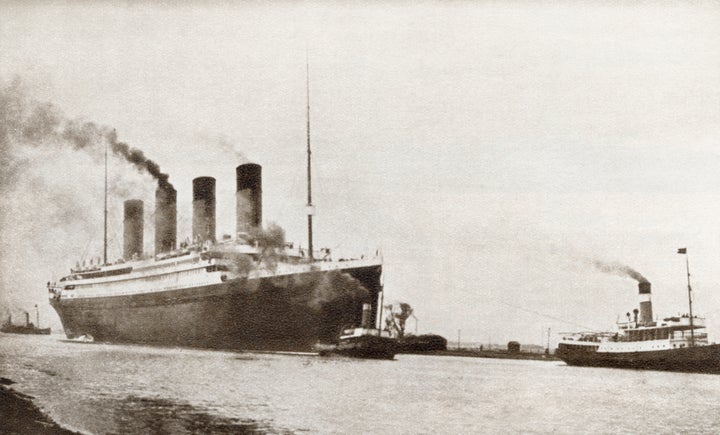
While the RMS Titanic left a lasting cultural legacy, the fate of its wealthiest passengers discussed in news and entertainment media, the history of the ship’s Chinese passengers has remained largely hidden.
And racist policies have a lot to do with it.
Out of the eight Chinese passengers aboard the ship, six survived the disaster that occurred off the coast of Newfoundland on April 15, 1912. But following their escape and eventual landing in the U.S., they were met with fierce anti-Chinese sentiment and strict immigration policies targeting those from China. The six were ultimately turned away at Ellis Island.
Their story is the subject of an upcoming documentary, “The Six,” to be released later this year. The film’s chief researcher, Steven Schwankert, told the South China Morning Post that his team hopes to set the record straight and address the attitudes that obscured the fate of the six travelers.
“Six Chinese guys made it off the Titanic alive and 24 hours later were written out of the story,” Schwankert said. “That wasn’t an accident. That was deliberate. It’s something that the culture of the time made happen.”
The passengers, who appeared to be from southern China, boarded the British ship in the English city of Southampton. In line with the way many ships handled third-class passengers a century ago, all eight of their names were written on a single ticket.
After the crash into an iceberg, four of the men escaped aboard the final lifeboat, according to news site Quartz. One made it onto another lifeboat while another, who was reportedly named Fang Lang, was picked up after being spotted floating in the wreckage. Records reveal that even that rescue was tinged with racism.
Officer Harold Lowe, who manned lifeboat 14, was said to have hesitated over saving the Chinese passenger, whom he called a “Jap,” a derogatory term used to describe individuals of Japanese descent.
“What’s the use?” Lowe said, according to lifeboat passenger Charlotte Collyer as reported in Encyclopedia Titanica. “He’s dead, likely, and if he isn’t, there’s others better worth saving than a Jap!”
But other passengers convinced Lowe to act. After he recovered his strength, Fang Lang proved to be a valuable member of the lifeboat and “worked like a hero,” rowing until they were rescued, Collyer later said. Lowe soon walked back his comments.
In part because most of the Chinese men survived the sinking of the Titanic ― even though women and children had been prioritized in the rush to the lifeboats ― their appearance in the U.S. was greatly scrutinized. A story in a 1912 issue of the Brooklyn Eagle offers a snapshot of the anti-Chinese bias aimed at the six men. Referring to them as “creatures” and “coolies,” the newspaper claimed that some of them were “found, wedged beneath the seats” of the lifeboats.
But documentary director Arthur Jones doesn’t believe that is accurate.
“We visited a large number of foreign archives and museums, worked with historians from the United States and China, searched and studied many [pieces of] evidence,” he told Xinhua News Agency. “There is no single [piece of] evidence to prove the Chinese survivors were stowaways [on the lifeboats]. I believe they did not do anything dishonorable.”
Other Western media outlets at the time also claimed that the Chinese passengers disguised themselves as women to escape the doomed ship ― another detail that the team producing “The Six” don’t buy.
“The press at the time labeled the Chinese survivors, referred to in places as ‘celestials,’ as cowards who dressed as women to sneak into lifeboats,” Schwankert told Quartz. “They had no basis for that, and we believe it’s just not true. … It’s time for these men to have their rightful place in history.”
Unlike the other passengers, these six survivors were ordered to leave the U.S. A century ago, American immigration policy was firmly set against the Chinese. The Chinese Exclusion Act of 1882 had initially barred all immigration of Chinese laborers for 10 years; the discriminatory policy was extended in 1892 by the Geary Act and made permanent in 1902 with even further restrictions. (The policy would not be ended until 1943 when China was a World War II ally.)
Little is known about the lives of the six men after their expulsion from the U.S. Their stories were mostly forgotten and if they were brought up in the press, “it was to say they did something dishonorable,” Jones told the South China Morning Post.
With the help of a social media campaign, however, the documentarians set out to track down their descendants. It was a difficult task, given that the survivors’ names have been recorded with varying spellings. But the team did make headway, according to the South China Morning Post. Their research led them from Wisconsin to the port city of Guangzhou.
Soon, the passengers will receive the treatment they deserve.
“We don’t accept the reports and the history as it is presented. The six Chinese men have been put into a position of injustice for more than a hundred years. We can finally tell their story rightly,” Schwankert told Xinhua.
